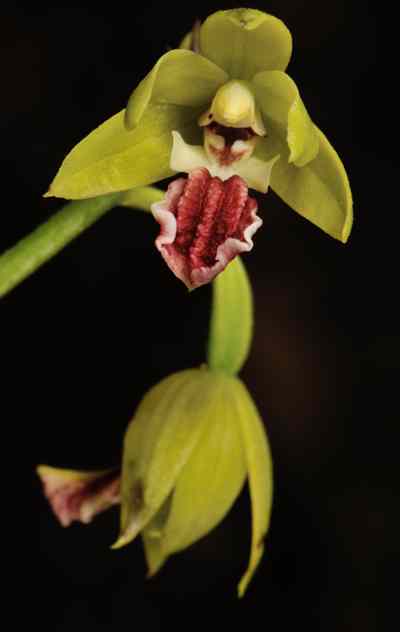The Plant
Terrestrial. Pseudo-bulbs small, ovoid, 1 to 1.5 cm long, with many stout roots. Pseudo-stem 4 to 6 cm long. Leaves three, unequal, oblanceolate, acute, much narrowed to its base, with short petiole, veined, 7 to 12 cm and 2 to 4 cm wide, petiole 1 to 1.5 cm long. Flowers many, laxly arranged, in a long erect peduncle arising amongst the leaves. Raceme less than half in length of peduncle.
The Flower
Flowers 2 to 4 cm across, pendulous. Sepals sub-equal, lanceolate; dorsal minutely wider than the lateral pair, apex margins curved to form a boat like structure, diagonally erect; lateral curved forward, apex like that of dorsal; both 1 to 3 veined. Petals as long as the lateral sepals, linear with pointed apex, curved forward, 1 veined. Lip broadly oblong, decurved, three lobed. The base forming a rounded cavity like depression with a didymous puberulous callus on the apex to its entrance. The basal lobes linear, spreading with its rounded apex curved up. The apical lobe oblong, obtuse, decurved, edges undulate, its disc with three parallel projecting ridges running its entire length with the middle one longer than the other two. Floral bracts very small, lanceolate, clasping, arising from the lower side of the stalked ovary.
Sepals and petals pale green. Outside of the sepals with few dark veins. The base of the lip pinkish purple, its callus creamy white. Basal lobes pale cream. The disc and the ridges of the apical lobe are reddish to purple turning white to the lip margin. Floral bract translucent, pale green.

The Pursuit
The alpine region starts around 8700 ft and above. According to the text of King and Pantling, the altitudinal range of this species was at 6000 ft. Hence, I never included this species in my search list for the alpine region. My place of stay was in a village around 8500 ft, their electricity was provided from a small hydro power station located near a huge waterfall. The village was provided with 24 hours of power supply, a very rare phenomenon in the Himalayas. However, due to some technical reasons coupled with hidden political agenda of people in authority, the generators of the power house went silent and authorities decided to construct a new power station with more production capacity a couple of kilometers away from the water falls. The contract was given to a private company, which brought in people from the plains of India to work there. As I was also staying in that village I developed a good friendship with some of the workers. They were fixing a huge iron pipe to carry water to the powerhouse from the waterfalls. The entire slope of the hill was cleared to fix several concrete pillars to support the iron pipeline. Every day I observed with distress the destruction happening to the floral population on that hill.
I moved to higher altitudes to document other in bloom. While I was camping much higher in the region, I received a vague message. It was sent by a driver of a transport vehicle carrying fresh vegetables to security personnel manning the high altitude posts. The message was short – “some flower in bloom, come down immediately”. In that region communication links are not available to verify the news or even proper transportation facilities to move around at ease. Hence, I decided to come down in the same vehicle when it returns after unloading the vegetables. I reached downhill by 6 PM in the evening and went to the camp office of the new construction company from where they had sent the message. On enquiry the person who was in the office confirmed that they found some plants in bloom and they believe it was an orchid and wanted me to see it. The word “orchid” made my adrenaline counts go up.
By then it was dark and climbing up hill was not possible. So I retired to rest in one of their cabins with my mind unrest with many thoughts on all possible species. During dinnertime, one of their staff came to me and shown a photograph he had taken on his mobile phone. He said that while they were clearing the slope they spotted this plant in bloom and wanted me to see it. I was surprised to see the photograph of this species. Till that time I never thought I will find this species from the alpine region. I had a sleepless night, as every time I closed my eyes the photograph of the plant in bloom was interrupting my sleep.
Next morning, I was up early to walk up the hill to the location of the plant. After a steep climb of around 30 minutes we were there. There were three plants, with several flowers, but mostly withered. One plant was left with two open flowers. I was disappointed that nobody noticed three plants before all its flowers withered off. I was left with no options other than be satisfied with those two flowers. I tried my level best to produce the best of the results from those two flowers. With God’s grace I succeeded in that.
My next priority was to make sure the construction activities going on the hill slope should not destroy the plants. I had a discussion with the man who is in charge of the whole work and explained to him the importance of the plant and its find. He was convinced to some extend and he fenced that small area to prevent any destruction. To date the iron fence still stands there protecting this species, with five plants appearing this season. I too made improvements in my notes and the documentary evidences by re-visiting those plants!!!
Reference:
King, G. & Pantling, R. (1898). The Orchids of the Sikkim-Himalayas. Ann. Roy. Bot. Garden. (Calcutta). Calanthe tricarinata Lindl., Page no 166.